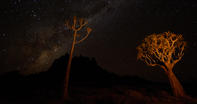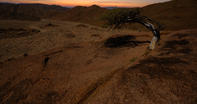The First Evidence
The first evidence of human beings in Namaqualand and the Richtersveld is represented by crude stone tools, such as choppers and hand axes fashioned from a stone pebble or core. These Early Stone Age implements are associated with various Homo species, such as Homo habilis, Homo erectus and archaic Homo sapiens, who lived between 2.5 million and 200 000 years ago.

Thus far, however, no human fossils have been found in this part of the world. The Middle Stone Age is said to range between 200 000 years and 35 000 years ago. This era marks a transition from core-based tools to flake based tools, a more sophisticated tool making technology in which slivers of rocks are struck off a stone core to create scrapers, blades or points.
Many examples of these smaller stone tools are found in Namaqualand, with several archaeological sites in the Richtersveld containing a large number of flakes and rock fragments, which suggests that they were tool ‘factories’. The West Coast National Park, near Langebaan, also contains a remarkably tangible fossil footprint made by one of our Homo sapiens ancestors during this era.
Human Habitation in the Richtersveld

The Later Stone Age coincides with the emergence of Homo sapiens sapiens, anatomically modern human beings just like you and me. The tools associated with this period are more refined and task-specific. They include blades, borers and points, many of which were attached to wooden shafts to form spears or knives.
Bone and ivory were also used to create blades, needles and even fishing hooks. Several archaeological sites in the Richtersveld (dating back to over 3000 years ago) offer evidence of this kind of technology.
Further testament to human habitation is also found in the form of processed animal bones, blackened hearths and a number of middens (prehistoric rubbish tips) containing human detritus, which are found with along the coast.
So, according to the archaeological evidence, nomadic hunter-gatherers have been living in Namaqualand and the Richtersveld for well over 200 000 years. It could not have been an easy life. Water would have been scarce (there is evidence of ostrich egg shells being used as storage containers) and there was always a risk of over-hunting. But, for once, humans seemed to understand that their survival depended on collaborating with the environment in a sustainable manner.
By David Fleminger